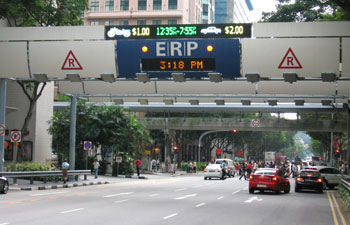The Best Inventory Management Software Systems in 2024
Choosing the right inventory management system is vital for the success of any business that deals with physical merchandise. Here are the top systems for industries like manufacturing, distribution, retail and e-commerce, and hospitality.

You can also listen to this article:
What is inventory management?
Inventory management is the systematic overseeing of the flow and storage of physical goods within an organization. More than just knowing what is in stock, it incorporates a slew of tasks such as order management, forecasting, and optimizing inventory levels.
As a fair amount of a company’s cash is tied up in inventory at any given time, it is vital for the success of the business to mindfully manage its wares. That means tracking each inventory movement and carefully planning replenishments to minimize the risk of both stockouts as well as overstocking.
Why is inventory management important?
Inventory management is like the central nervous system of any business that deals with physical goods. Its significance lies in:
- Stock level optimization. Maintaining the right inventory levels means you’re not sinking money into overstocking, nor are you missing out on sales due to stockouts.
- Inventory tracking. Knowing what you have in stock and where each item is located will not only make inventory handling and picking more efficient, but it can also aid you in preventing dead stock.
- More efficient replenishment. Automated purchase processes and reorder points eliminate manual tracking and the errors that come with it.
- Reduced inventory-related bottlenecks. Efficient inventory management ensures that raw materials get to the shop floor in due time, eliminating downtime due to stockouts, and that goods are shipped to the customer promptly.
- Upgraded customer service. Effective inventory tracking and replenishments enable you to quickly fulfill customer orders, thereby enhancing customer satisfaction.
- Profitability boost. The ability to win more sales and automate inventory-related workflows directly correlates with an increase in profitability.
Without proper inventory management practices, no company can survive for very long. Mindful inventory control, however, can take a business to new heights.
Benefits of cloud-based inventory management software
Inventory management software is designed to automate inventory tracking, purchasing, and analytics processes while providing companies with a real-time overview of their inventory. Investing in cloud-based inventory management software comes with a treasure trove of benefits, including:
- Live updates on inventory levels and order statuses.
- Recording of each inventory movement for traceability purposes.
- Low stock notifications that are tied to your reorder points.
- Expiry date tracking for perishable goods management.
- Improved communication thanks to everyone having access to up-to-date information coming from the same source.
- Automatically compiled reports and statistics for making truly informed business decisions.
- Multi-site management for effective control over geographically dispersed facilities.
- Seamless integrations with e-commerce platforms like Shopify, WooCommerce, and Amazon, as well as with accounting software like QuickBooks and Xero.
- Access from anywhere with an internet connection, including with mobile devices using iOS, Android, or Windows operating systems.
- No on-site servers and expensive hardware.
- Scalability for growing the business without inflating the administrative side.
In addition, all those benefits can be attained without breaking the bank – there are effective cloud-based inventory management systems out there that cost less than $50/month.
Industry-specific inventory management software requirements
When ditching the spreadsheets and replacing them with proper inventory management software, business owners and managers need to think about the specifics of their industry. Here are the requirements various industries have when it comes to inventory management.
Retail and e-commerce
Retail and e-commerce companies gave very similar requirements when it comes to inventory management software. While retail businesses need a point-of-sale (POS) system integrations, for e-commerce businesses, multi-channel support is non-negotiable. Your inventory management system should enable you to manage sales across various sales channels like Amazon, eBay, Etsy, and Shopify from a unified dashboard. Other key features include:
- Order fulfillment. Streamlining the end-to-end order management process, from sales orders to shipping labels, is essential for smooth operations.
- SKU management. Stock-keeping units (SKUs) form the basis for tracking inventory.
- Low stock alerts. Getting instant notifications when a product is running out of stock enables retailers and e-commerce managers to promptly replenish inventory, thereby preventing stockouts.
- Purchase management. Retailers and e-commerce businesses need to be able to streamline their purchasing process and have an overview of their purchase orders and suppliers.
- Bundling. The system should allow for easy product bundling, a common practice in e-commerce businesses.
- Integration with accounting software. To conform to accounting regulations, using accounting software is essential. Having your accounting solution sync with your inventory management tool automates a large part of bookkeeping.
Unless the company is dropshipping, i.e. just intermediating orders between a customer and a fulfillment company, a proper inventory management system is vital for the continued success of the business.
Distribution
Distributors require advanced inventory management features that go much further from basic inventory tracking and order fulfillment:
- Demand forecasting. Businesses that deal with hundreds or thousands of products need to be able to look at historical data related to those products in order to accurately forecast their demand.
- Barcode scanning. Barcode scanners facilitate efficient large-scale inventory counting and verification.
- Real-time inventory tracking. Distributors need to know their stock levels at all times to make quick and informed decisions.
- Multi-warehouse support. The ability to manage inventory across multiple locations is critical for distributors with expansive operations.
- Order management. An efficient system for creating and tracking purchase orders and sales orders is a must.
- Reorder points. Setting reorder points helps in maintaining optimal stock levels and prevents stockouts or overstocking. Reorder points can be tied to low stock alerts sent as notifications when inventory levels drop below the ROP.
- Supply chain visibility. A comprehensive overview of the supply chain, from suppliers to customers, is crucial for planning and execution.
- Integration capabilities. The ability to seamlessly integrate with other systems like CRM, ERP, and accounting software is vital for a cohesive workflow.
- Shipping and logistics. Integration with shipping carriers and logistic tools are necessary for tracking shipments and ensuring timely delivery.
- Reporting and analytics. Robust reporting tools are needed to analyze inventory turnover, profitability, and other key performance indicators.
- Price and discount management. The ability to set and manage complex pricing and discount structures is often needed in distribution.
Therefore, effective warehouse management software is a must for wholesalers whose business needs range from precise inventory planning and tracking to sales management and fulfillment.
Manufacturing
In addition to most of the functionality needed by distributors, manufacturers need inventory management functionality that is tied into their production planning processes. Therefore, a standalone inventory management module is not enough, and an MRP or a manufacturing ERP system is needed to keep the operation running like clockwork. The core features of an MRP system are:
- Bill of materials (BOM) and production routing. Defining the bills of materials and routings of your products sets a basis for standardization, which allows your company to manufacture a product repeatably each time. In addition, BOMs and routings form the jumping-off point for production planning and scheduling.
- Production planning and scheduling. This enables manufacturers to allocate resources, optimize machine usage, and prioritize jobs to ensure timely delivery and minimize production costs.
- Lot and serial number tracking. Essential for manufacturers who need to keep tabs on raw materials and end-products through every stage of the manufacturing process.
- Quality inspections. Manufacturers need to be able to track the quality of both incoming goods as well as manufactured products.
- Production reporting. Tracking their key performance indicators (KPIs) such as production efficiency, on-time delivery rates, and supplier delays gives manufacturers valuable insights for process improvements.
- Work-in-process inventory accounting. Manufacturers need to be able to track and account for items that are still in the process of being manufactured.
- Cost analysis. Knowing your production costs is essential for ensuring the financial well-being of your company. Real-time cost analysis becomes increasingly important when material prices fluctuate, enabling companies to change suppliers, ingredients, or selling prices when needed.
- Subcontracting. This helps manufacturers manage and coordinate with contract manufacturers, ensuring that timelines, costs, and quality standards are met.
- Maintenance management. Manufacturers have to manage the maintenance of machinery to ensure that equipment is in optimal working condition and unplanned downtime is minimized.
- Returns/repairs management. While any manufacturer needs to deal with product returns at some point, OEM manufacturers also need to take care of warranty repairs. A return merchandise authorization (RMA) module enables manufacturers to systematically manage that.
- Kitting. Manufacturers often kit together materials and components used in the same stages of a production process, thereby reducing picking time and streamlining production.
These are only some of the core features manufacturers need from their business management software. Depending on the nature of the manufactured products, some manufacturers require highly specific functionality in addition to these.
HoReCa (Hotel, Restaurant, Catering)
In the HoReCa sector, inventory management needs are quite unique due to the variety of goods involved and the fast-paced environment. Key functionalities include:
- POS system integration. A seamless interface with point-of-sale systems is essential for real-time inventory updates.
- Low stock notifications. The software should alert you when stock levels of essential items like food and beverages fall below a predetermined point.
- Lot and serial number tracking. This is particularly important for managing perishables and high-value items like premium liquors.
- Waste management. The system should help you track and minimize waste, which is very important in the food industry.
- Recipe management. For restaurants, the ability to manage recipes, along with the inventory of each ingredient, can be a big plus.
- Seasonal forecasting. Given the seasonality in the HoReCa industry, forecasting tools can help plan inventory needs efficiently.
- Event planning. For catering services, the system should offer features that help plan and manage inventory for specific events.
- Vendor management. The ability to track and manage relationships with multiple vendors can streamline the procurement process.
- Customer preference tracking. Understanding customer preferences can help in better inventory planning, especially for eateries and hotels.
The functionality needed in HoReCa therefore overlaps with some of the functionality required in the retail, distribution, and manufacturing industries. Sector-specific requirements, however, make regular inventory management systems unsuitable for hospitality businesses.
The best inventory management software systems by industry
Based on the requirements highlighted above, here are the best inventory management software solutions for each industry:
Retail and e-commerce: Square for Retail
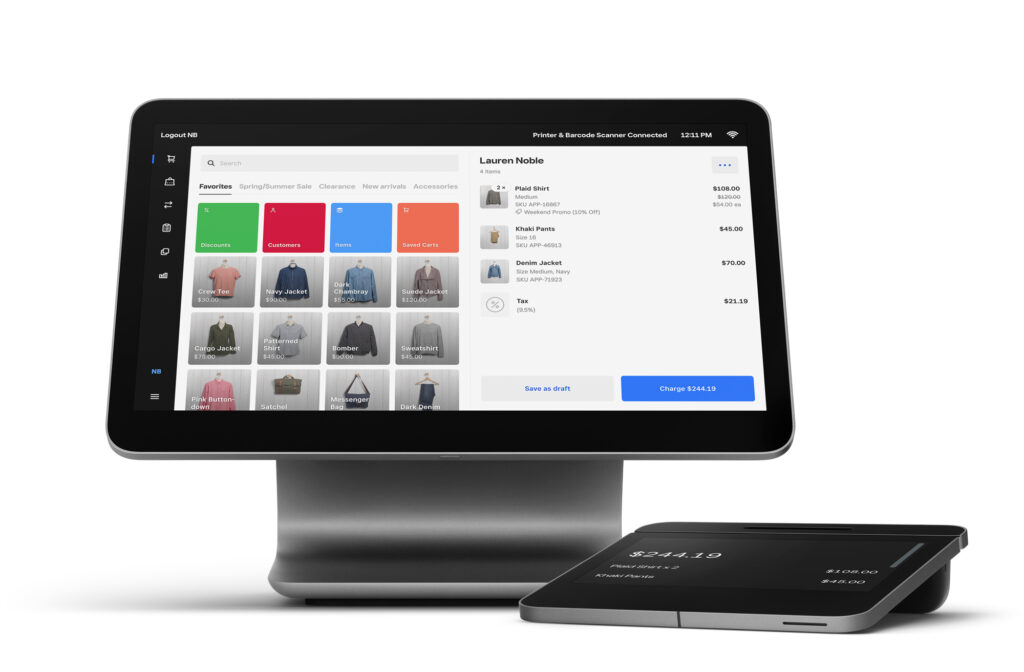
Square is an inventory management solution used in a wide range of businesses, from restaurants to beauty salons and other service industry companies. Where Square really shines in, however, is retail and e-commerce inventory management. Being user-friendly and affordable enough even for microbusinesses, it still boasts an impressive functionality package.
Square for Retail offers real-time tracking, automatic stock level alerts, and easy item categorization. Its robust point-of-sale (POS) system is particularly advantageous for brick-and-mortar stores, streamlining checkout processes and improving customer experience. For e-commerce, Square supports online sales through its integration with popular e-commerce platforms, facilitating a unified approach to sales and inventory across multiple channels. Additionally, Square’s detailed analytics and reporting provide insights into sales trends, inventory turnover, and customer preferences, aiding in strategic decision-making.
Distribution: Oracle NetSuite
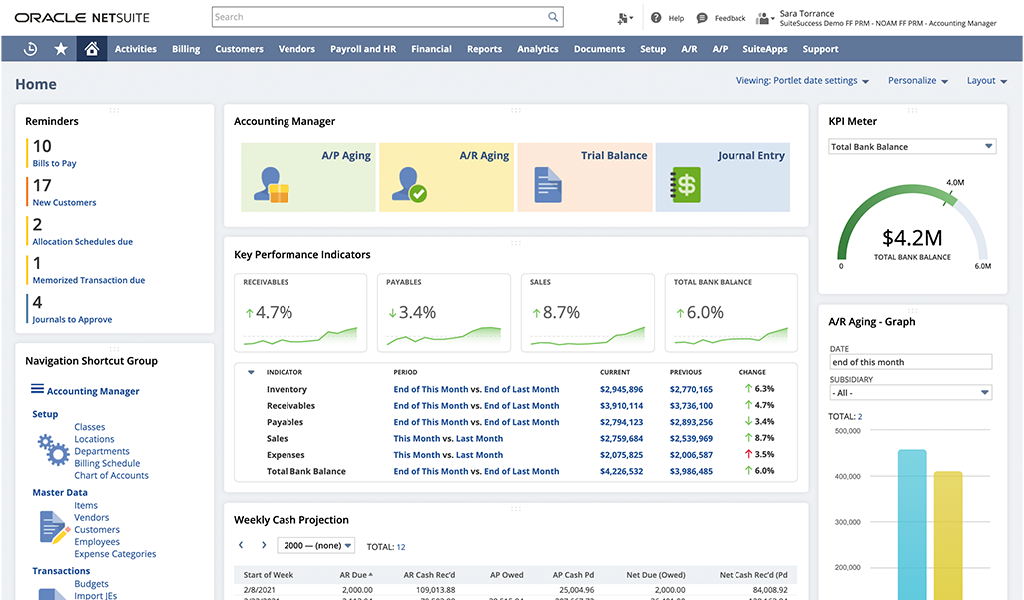
Oracle NetSuite is a good choice for distribution businesses due to its comprehensive, cloud-based ERP solution that does not only improve inventory management efficiency but streamlines the whole operation. It offers real-time visibility across the entire organization, enabling distributors to make informed business decisions.
NetSuite’s robust inventory management capabilities, including demand planning, automated replenishment, and advanced warehousing, ensure optimal stock levels and efficient order fulfillment. Its seamless integrations with various platforms facilitate data synchronization, eliminating data silos and fostering collaboration across departments. Additionally, NetSuite’s multi-currency and multi-language support, equips distributors to effortlessly manage international transactions.
Manufacturing: MRPeasy
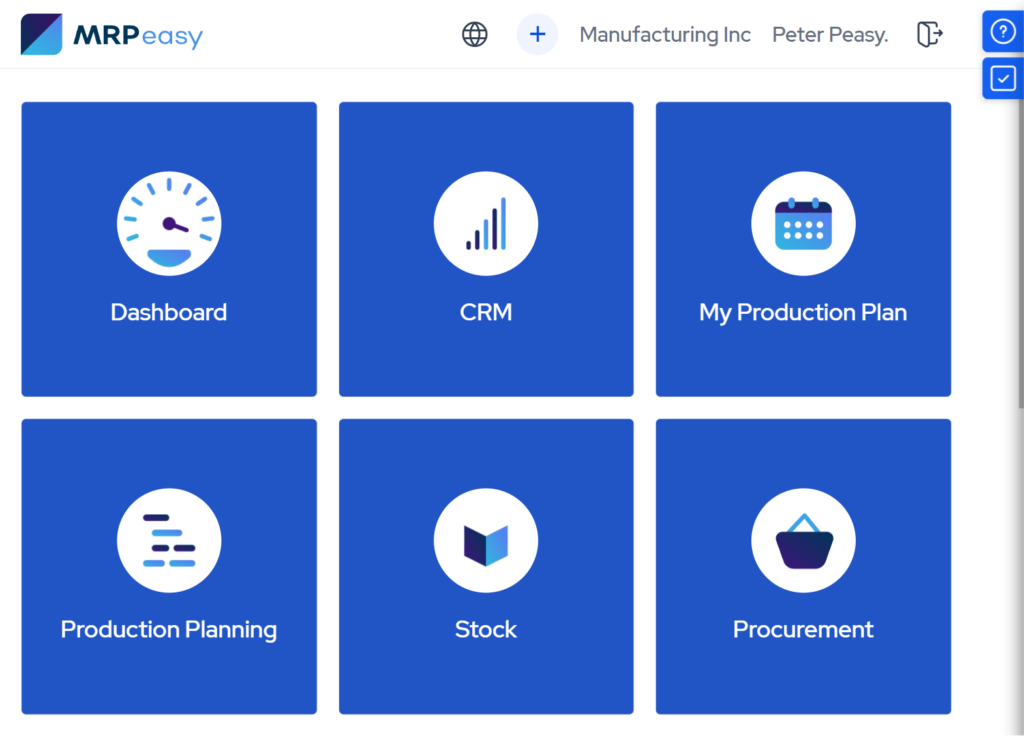
Although also suitable for distribution SMEs, MRPeasy works best for small and medium-sized manufacturing businesses. From bills of materials to quality control, shop floor reporting, and full traceability, MRPeasy wraps it all into an intuitive, customizable package.
What sets MRPeasy apart from other inventory management systems is that the system is built around the core manufacturing management functionality. Everything starts from defining the bills of materials or ingredient lists of your products and tying them to inventory items. The software can then already be used for material requirements planning which is a vital part of inventory management and production planning. After you have defined your production routings, i.e. the activity sequences of production processes, and their associated labor costs, the software can start providing you with accurate lead time and cost estimations while automatically scheduling confirmed manufacturing orders.
The software also has a production reporting module, enabling companies to pull data from the shop floor and use metrics and statistics to get insights into their operational efficiency. In addition, MRPeasy generates reports about supplier performance, inventory management effectiveness, sales, finances, and more.
A simple maintenance management module enables companies to set maintenance notifications that are tied to either processed units or machinery uptime. Handling returns, repairs, and recalibrations is also made easy with the system’s RMA module.
In addition, MRPeasy integrates with many third-party apps, including e-commerce, accounting, fulfillment, and CRM systems. A native integration with the app connectivity hub Zapier expands the available options even further, as does the open API MRPeasy offers with its Unlimited package.
Most importantly, MRPeasy gives businesses complete control and an accurate overview of their inventory, allowing them to minimize the risk of stockouts and overstocking.
Clients often laud MRPeasy for its simple onboarding process, reliable customer support, and the high level of functionality they get, especially when considering the cost of the system.
HoReCa: Marketman
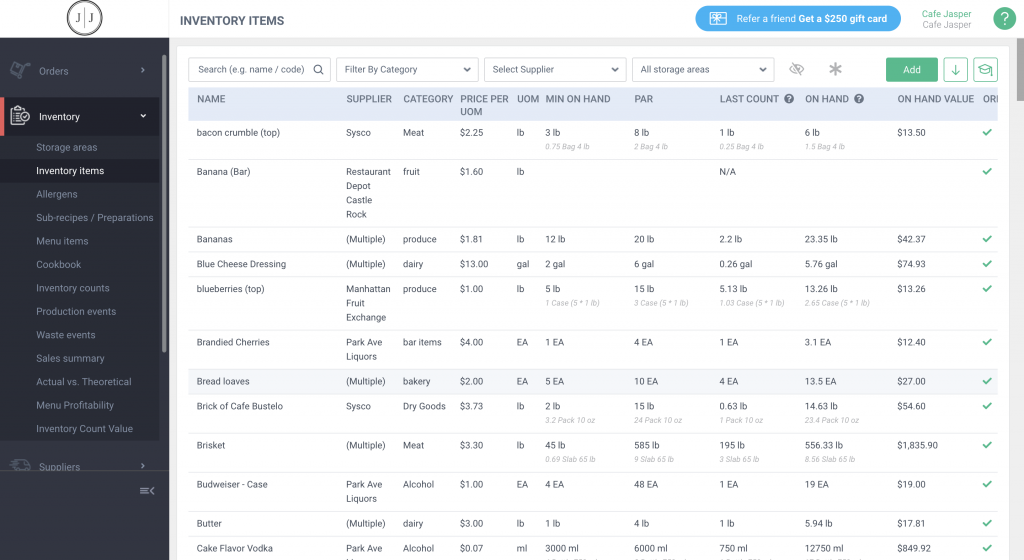
Marketman shines as an inventory management solution for the hospitality sector with its specialized features tailored to the unique challenges of the industry.
Its strength lies in its precise inventory tracking and real-time data updates, which are critical for managing perishable items and high-velocity goods. Marketman offers robust tools for recipe management and menu costing, ensuring that businesses can maintain consistency and control food costs effectively.
The platform also excels in supplier management, streamlining the ordering process and fostering better supplier relationships. With its user-friendly interface, Marketman simplifies complex inventory tasks, making it accessible to all staff members regardless of their technical skills. Additionally, its detailed analytics help in making informed purchasing decisions and in identifying demand trends for better forecasting. These features, combined with seamless POS integration, make Marketman a good choice for HoReCa businesses looking to optimize their inventory management and operational efficiency.
Conclusion
The landscape of inventory management software in 2024 is rich with solutions tailored to specific industry needs. From retail and e-commerce to manufacturing and HoReCa, each sector has unique requirements that are addressed by different software systems. The key takeaway is the critical role of inventory management in business success, irrespective of the industry. Proper inventory management not only streamlines operations but also significantly boosts profitability and customer satisfaction.
With advancements in IT systems, particularly cloud-based solutions, businesses now have access to powerful tools that provide real-time insights, automate critical processes, and enhance decision-making. These systems help effectively manage inventories while also integrating seamlessly with other business processes, creating a cohesive and efficient workflow.
You may also like: Best Manufacturing ERP – Top 6 Software Solutions in 2023
